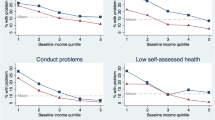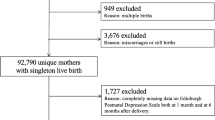Abstract
Maternal depression is a common health problem during the perinatal period. The purpose of this study was to examine changes in the relationship between socioeconomic position and maternal depressive symptoms from prenatal to 3 years postpartum in Korean women. Prospective cohort data were collected from the Panel Study on Korean Children between 2008 and 2011. Maternal depression was assessed using the Kessler 6-Item Psychological Distress Scale. Socioeconomic position indicators used were maternal education, paternal education, maternal occupation, paternal occupation, and household income. Repeated-measures analyses with a generalized estimating equation approach were used to investigate relationships between socioeconomic position and maternal depressive symptoms during the study period. Low socioeconomic position was associated with greater levels of maternal depressive symptoms between 4 months after childbirth and 3 years postpartum, but the association was not evident between 1 month before and after childbirth. The magnitude of the significant association between socioeconomic position and maternal depression was the greatest at 1 year postpartum but then became smaller. Among the five socioeconomic position indicators included, maternal education, paternal education, and household income showed graded inverse relationships with maternal depressive symptoms, while no significant relationship was found for paternal occupation over the study period. Socioeconomic inequalities in maternal depressive symptoms emerged in early childhood in a prospective study of Korean mothers. These emerging inequalities may contribute to socioeconomic inequalities in childhood health and development.
Similar content being viewed by others

References
Bennett, H. A., Einarson, A., Taddio, A., Koren, G., & Einarson, T. R. (2004). Prevalence of depression during pregnancy: Systematic review. Obstetrics and Gynecology, 103, 698–709.
Gavin, N. I., Gaynes, B. N., Lohr, K. N., Meltzer-Brody, S., Gartlehner, G., & Swinson, T. (2005). Perinatal depression: A systematic review of prevalence and incidence. Obstetrics and Gynecology, 106, 1071–1083.
Cummings, E. M., Schermerhorn, A. C., Keller, P. S., & Davies, P. T. (2008). Parental depressive symptoms, children’s representations of family relationships, and child adjustment. Social Development, 17, 278–305.
Elgar, F. J., Mills, R. S. L., McGrath, P. J., Waschbusch, D. A., & Brownridge, D. A. (2007). Maternal and paternal depressive symptoms and child maladjustment: The mediating role of parental behavior. Journal of Abnormal Child Psychology, 35, 943–955.
Goodman, S. H., & Gotlib, I. H. (1999). Risk for psychopathology in the children of depressed mothers: A developmental model for understanding mechanisms of transmission. Psychological Review, 106, 458–490.
Lim, J. H., Wood, B. L., & Miller, B. D. (2008). Maternal depression and parenting in relation to child internalizing symptoms and asthma disease activity. Journal of Family Psychology, 22, 264–273.
Grote, N. K., Bridge, J. A., Gavin, A. R., Melville, J. L., Iyengar, S., & Katon, W. J. (2010). A meta-analysis of depression during pregnancy and the risk of preterm birth, low birth weight, and intrauterine growth restriction. Archives of General Psychiatry, 67, 1012–1024.
Cents, R. A., Diamantopoulou, S., Hudziak, J. J., et al. (2013). Trajectories of maternal depressive symptoms predict child problem behaviour: The generation R study. Psychological Medicine, 43, 13–25.
McMahon, C. A., Barnett, B., Kowalenko, N. M., & Tennant, C. C. (2006). Maternal attachment state of mind moderates the impact of postnatal depression on infant attachment. Journal of Child Psychology and Psychiatry, 47, 660–669.
Augustine, J. M., & Crosnoe, R. (2010). Mothers’ depression and educational attainment and their children’s academic trajectories. Journal of Health and Social Behavior, 51, 274–290.
Hammen, C., Brennan, P. A., & Keenan-Miller, D. (2008). Patterns of adolescent depression to age 20: The role of maternal depression and youth interpersonal dysfunction. Journal of Abnormal Child Psychology, 36, 1189–1198.
Weissman, M. M., Pilowsky, D. J., Wickramaratne, P. J., et al. (2006). Remissions in maternal depression and child psychopathology: A STAR* D-child report. JAMA, 295, 1389–1398.
Murray, L., Arteche, A., Fearon, P., Halligan, S., Goodyer, I., & Cooper, P. (2011). Maternal postnatal depression and the development of depression in offspring up to 16 years of age. Journal of the American Academy of Child and Adolescent Psychiatry, 50, 460–470.
Stein, A., Pearson, R. M., Goodman, S. H., et al. (2014). Effects of perinatal mental disorders on the fetus and child. The Lancet, 384, 1800–1819.
Bradshaw, P. (2011). Growing up in Scotland: Changes in child cognitive ability in the pre-school years. Edinburg: Scottish Government.
Feinstein, L. (2003). Inequality in the early cognitive development of children in the 1970 cohort. Economica, 70, 73–97.
Heckman, J. J. (2006). Skill formation and the economics of investing in disadvantaged children. Science, 312, 1900–1902.
Shonkoff, J. P., Boyce, W. T., & McEwen, B. S. (2009). Neuroscience, molecular biology, and the childhood roots of health disparities building a new framework for health promotion and disease prevention. JAMA, 301, 2252–2259.
Turney, K. (2011). Maternal depression and childhood health inequalities. Journal of Health and Social Behavior, 52, 314–332.
Turney, K. (2012). Pathways of disadvantage: Explaining the relationship between maternal depression and children’s problem behaviors. Social Science Research, 41, 1546–1564.
Beeghly, M., Olson, K. L., Weinberg, M. K., Pierre, S. C., Downey, N., & Tronick, E. Z. (2003). Prevalence, stability, and socio-demographic correlates of depressive symptoms in black mothers during the first 18 months postpartum. Maternal and Child Health Journal, 7, 157–168.
Dearing, E., Taylor, B. A., & McCartney, K. (2004). Implications of family income dynamics for women’s depressive symptoms during the first 3 years after childbirth. American Journal of Public Health, 94, 1372–1377.
Matijasevich, A., Golding, J., Smith, G. D., Santos, I. S., Barros, A. J., & Victora, C. G. (2009). Differentials and income-related inequalities in maternal depression during the first two years after childbirth: Birth cohort studies from Brazil and the UK. Clinical Practice and Epidemiology in Mental Health, 5, 12.
Mayberry, L. J., Horowitz, J. A., & Declercq, E. (2007). Depression symptom prevalence and demographic risk factors among U.S. women during the first 2 years postpartum. Journal of Obstetric, Gynecologic, and Neonatal Nursing, 36, 542–549.
Yagmur, Y., & Ulukoca, N. (2010). Social support and postpartum depression in low-socioeconomic level postpartum women in Eastern Turkey. International Journal of Public Health, 55, 543–549.
Adewuya, A. O., Fatoye, F. O., Ola, B. A., Ijaodola, O. R., & Ibigbami, S. M. (2005). Sociodemographic and obstetric risk factors for postpartum depressive symptoms in Nigerian women. Journal of Psychiatric Practice, 11, 353–358.
Miyake, Y., Tanaka, K., & Arakawa, M. (2012). Employment, income, and education and prevalence of depressive symptoms during pregnancy: The Kyushu Okinawa maternal and child health study. BMC Psychiatry, 12, 117.
Goyal, D., Gay, C., & Lee, K. A. (2010). How much does low socioeconomic status increase the risk of prenatal and postpartum depressive symptoms in first-time mothers? Women’s Health Issues, 20, 96–104.
Seguin, L., Potvin, L., St-Denis, M., & Loiselle, J. (1999). Socio-environmental factors and postnatal depressive symptomatology: A longitudinal study. Women and Health, 29, 57–72.
Lau, Y., & Keung, D. W. (2007). Correlates of depressive symptomatology during the second trimester of pregnancy among Hong Kong Chinese. Social Science and Medicine, 64, 1802–1811.
Segre, L. S., O’Hara, M. W., Arndt, S., & Stuart, S. (2007). The prevalence of postpartum depression: The relative significance of three social status indices. Social Psychiatry and Psychiatric Epidemiology, 42, 316–321.
Galobardes, B., Shaw, M., Lawlor, D., Smith, G. D., & Lynch, J. W. (2006). Indicators of socioeconomic position. In J. M. Oakes & J. S. Kaufman (Eds.), Methods in social epidemiology (pp. 47–85). Hoboken: Wiley.
Kessler, R. C., Barker, P. R., Colpe, L. J., et al. (2003). Screening for serious mental illness in the general population. Archives of General Psychiatry, 60, 184–189.
Shin, N., Lee, J., Kim, M., et al. (2007). Panel study on Korean children: Preliminary report. Seoul: Korea Institute of Child Care and Education.
Kessler, R. C., Andrews, G., Colpe, L. J., et al. (2002). Short screening scales to monitor population prevalences and trends in non-specific psychological distress. Psychological Medicine, 32, 959–976.
Kessler, R. C., Mcgonagle, K. A., Nelson, C. B., Hughes, M., Swartz, M., & Blazer, D. G. (1994). Sex and depression in the national comorbidity survey. 2. Cohort effects. Journal of Affective Disorders, 30, 15–26.
Ertel, K. A., Rich-Edwards, J. W., & Koenen, K. C. (2011). Maternal depression in the United States: Nationally representative rates and risks. Journal of Women’s Health, 20, 1609–1617.
Kessler, R. C., Mcgonagle, K. A., Swartz, M., Blazer, D. G., & Nelson, C. B. (1993). Sex and depression in the national comorbidity survey. 1. Lifetime prevalence, chronicity and recurrence. Journal of Affective Disorders, 29, 85–96.
Wang, L., Wu, T., Anderson, J. L., & Florence, J. E. (2011). Prevalence and risk factors of maternal depression during the first three years of child rearing. Journal of Women’s Health, 20, 711–718.
Seo, Y. S., Park, H. S., & Lee, S. O. (2003). Assessment of the home postpartum care among puerperal women in a metropolitan city. Journal of the Korean Society of Maternal and Child Health, 7, 57–69.
Kim, T. K., & Yoo, E. K. (1998). A correlational study on the level of importance & performance of postpartal care and its relationship with women’s health status. Korean Journal of Women Health Nursing, 4, 145–161.
Lim, H. J., & Lee, D. K. (2012). The effect of couples` characteristics, economic characteristics, mother`s psychological characteristics on infant mother`s marital satisfaction for working mothers and homemaker mothers. Korean Journal of Early Childhood Education, 32, 451–470.
Lim, H. J. (2013). The differences of infant’s temperament, mothers’ psychological characteristic, mothers’ parenting style as a function of types of employment status of mothers. Korean Journal of Child Care and Education Policy, 7, 190–214.
Park, M. H. (1991). Patterns and trends of educational mating in Korea. Korea Journal of Population and Development, 20, 1–15.
Kye, B., & Mare, R. D. (2012). Intergenerational effects of shifts in women’s educational distribution in South Korea: Transmission, differential fertility, and assortative mating. Social Science Research, 41, 1495–1514.
Ballinger, G. A. (2004). Using generalized estimating equations for longitudinal data analysis. Organizational Research Methods, 7, 127–150.
Howard, L. M., Piot, P., & Stein, A. (2014). No health without perinatal mental health. The Lancet, 384, 1723–1724.
Acknowledgments
This research was supported by the Basic Science Research Program through the National Research Foundation of Korea (NRF) funded by the Ministry of Education (Grant Number: 2013R1A1-A2009752).
Ethical standard
This study was conducted with the approval of the Asan Medical Center Institutional Review Board.
Author information
Authors and Affiliations
Corresponding author
Electronic supplementary material
Below is the link to the electronic supplementary material.
Rights and permissions
About this article
Cite this article
Bahk, J., Yun, SC., Kim, Ym. et al. Changes in the Relationship Between Socioeconomic Position and Maternal Depressive Symptoms: Results from the Panel Study on Korean Children (PSKC). Matern Child Health J 19, 2057–2065 (2015). https://doi.org/10.1007/s10995-015-1718-x
Published:
Issue Date:
DOI: https://doi.org/10.1007/s10995-015-1718-x



